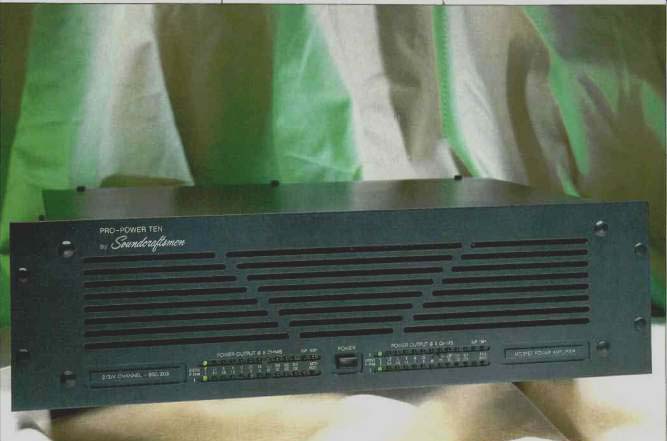
Manufacturer's Specifications
Power Output: Four-channel mode, 205 watts per channel into 8 ohms from 20 Hz to 20 kHz, 300 watts per channel into 4 ohms: two-channel mode, 600 watts per channel into 8 ohms.
THD: 0.05%.
SMPTE-IM Distortion: 0.05%.
Frequency Response: 20 Hz to 20 kHz, ±0.1 dB.
S/N: -105 dB.
Slew Rate: 50 V/uS.
Dimensions: 19 in. W x 5 1/4 in. H x 12 in. D (48.3 cm x 13.3 cm x 30.5 cm).
Weight: 55 lbs. (25 kg).
Price: $1,399.
Company Address: 2200 South Ritchey, Santa Ana, Cal. 92705.
This new amplifier from Soundcraftsmen uses Class AB MOS-FET power output stages and the manufacturer's phase-controlled power supplies. Soundcraftsmen chose to use a rather stiff power supply-one that adjusts its supply voltage to match the demands of the loudspeaker. Thus, you won't find much "dynamic headroom" in this amplifier but then again, you won't need much, in view of this unit's continuous power rating.
The Pro-Power Ten is actually two separate stereo amplifiers, each with its own massive power transformer and ultra high-storage filter capacitors. Each of these stereo amplifiers can be "bridged," allowing four-, three-, or two-channel operation. Unbridged, the amplifier is especially suited for use in surround systems. When operated in the three-channel mode, with one pair of channels bridged together, the amp lends itself to driving a pair of satellites with a power hungry common subwoofer.
I have always admired Soundcraftsmen's straightforward designs, and the Pro-Power Ten is no exception. After first subjecting the amplifier to the FTC preconditioning test for one hour at one-third its rated power, I removed the cover.
There were no great surprises inside--just high-quality components, well located, and a prominently visible pair of huge power transformers. During the course of my tests, I confirmed the fact that the two halves of the Pro-Power Ten are completely independent--from the primary windings of their respective power transformers down to the speaker output terminals. The Pro-Power Ten amp is completely protected against short-circuits, open circuits, and input overloads. Thermal protection is provided by multi-sensor phase-control regulation.
Control Layout
The Pro-Power Ten's front panel features four independent 12-segment LED power output meters calibrated from 0 to 800 watts, referenced to 8-ohm loads. Clipping indicators for each channel are also found on the front panel. As is true of many other Soundcraftsmen power amplifiers I have tested over the years, this unit incorporates a rack-mountable front panel, but optional hardwood side panels are available to "dress up" the unit for domestic use The folks at Soundcraftsmen tell me that a Pro-Power Nine model will be available and will be similar to the Pro-Power Ten I tested, except the LED power meter displays will be omitted. It will carry a suggested price $100 lower than that of the Pro-Power Ten.
The rear panel is equipped with color-coded five-way binding posts on standard 3/4-inch centers for connecting speaker cables. Channels are indentified "A," "B," "C," and "D," rather than "Left" or "Right," and the unbalanced phono-type input jacks are similarly labeled. Separate slide switches for each pair of amp channels are used for switching to the bridged mode of operation.
Measurements
Except where stated otherwise, I hooked up the Pro-Power Ten as a four-channel amp for all my tests and measurements. When testing the amp in this mode, I drove all four inputs and connected separate loads (first 8 ohms, then 4 ohms) to each output.
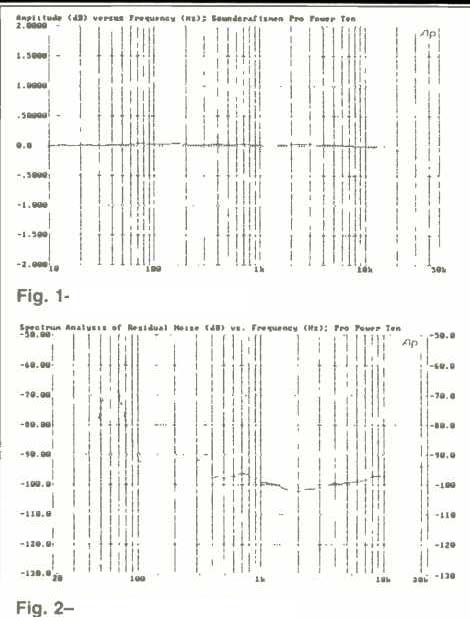
Fig. 1-Frequency response of the Soundcraftsmen Pro-Power Ten amplifier.
Fig. 2-Spectrum analysis of residual noise for left channel (solid curve) and right channel (dashed curve).
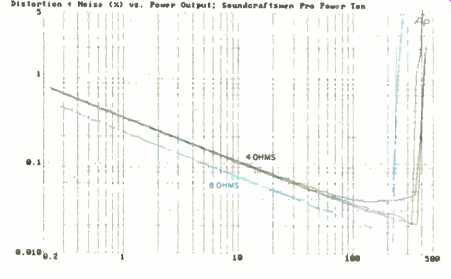
Fig. 3-THD + N vs. power output into 8- and 4-ohm loads. Just before curves
slope upward, top curve is 20 kHz, straightest curve is 1 kHz, and remaining
curve is 20 Hz.
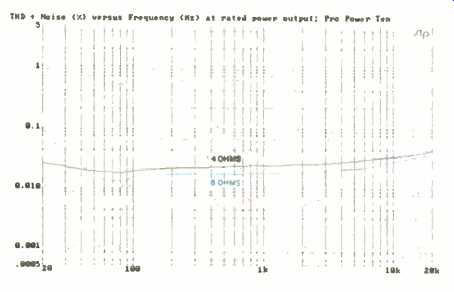
Fig. 4-THD + N vs. frequency, at rated power, for 8- and 4-ohm loads.
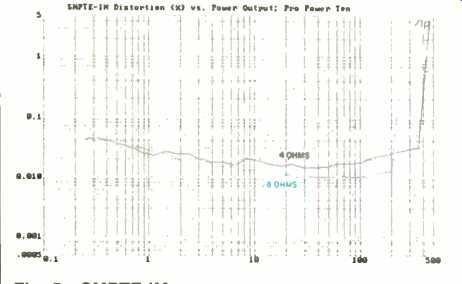
Fig. 5-SMPTE-IM distortion vs. power output for 8- and 4-ohm loads.
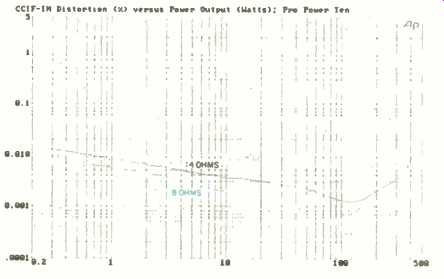
Fig. 6-CCIF-IM distortion vs. power output for 8 and 4-ohm loads.
Figure 1 shows the frequency response of one channel of the amplifier. Response was flat to within + 0,-0.1 dB from 10 Hz to 20 kHz. At 50 kHz, response was down only 0.5 dB.
I measure the S/N ratio of an amplifier with respect to 1 watt output, as mandated by the EIA Amplifier Measurement Standard. Soundcraftsmen and others continue to publish S/N specifications referred to rated output. I guess the desire to come up with higher numbers outweighs the need to follow an industry-accepted standard. In any case, where there is no volume control involved--as with the Pro-Power Ten--it's easy enough to translate one form of S/N reading to the other. I measured an A-weighted S/N value of 82 dB, referred to 1 watt output. Now 205 watts of output is slightly more than 23 dB greater than 1 watt, so the S/N referred to rated output would be very slightly greater than 105 dB exactly the value claimed by Soundcraftsmen in their published specifications.
I also used the spectrum-analyzer, or bandpass, function of my Audio Precision System One test gear to analyze the nature of the residual noise (again referred to 1 watt output but with no weighting curve). I discovered that much of the residual noise that contributed to the previous A-weighted overall measurement of S/N was caused by some residual power-supply hum and its harmonics, as shown in Fig. 2.
Still, an A-weighted S/N of 82 dB below 1 watt--or 105 dB below 105 watts--is no cause for concern or criticism. Few amplifiers I have tested do much better than that.
Figure 3 is a plot of THD + N versus power output into 8 and 4-ohm loads. Each plot was repeated three times for three different reference frequencies: 1 kHz, 20 Hz, and 20 kHz. At 205 watts per channel into 8 ohms, THD + N was only 0.017% at 1 kHz, 0.02% at 20 Hz, and 0.038% at 20 kHz. At the rated output of 300 watts per channel into 4 ohms, THD + N was 0.023% at 1 kHz and 20 Hz. For a 20 kHz test signal, THD + N was somewhat higher, 0.042%, but still well below the 0.05% claimed by Soundcraftsmen.
At 1 kHz, the amp was able to deliver nearly 370 watts per channel into 4-ohm loads, with all channels driven. While the plots of Fig. 3 are for one channel only, measurements at the outputs of the other three channels revealed that distortion levels were substantially the same at rated output.
Figure 4 shows how THD + N varied with frequency at the rated power output values of 205 and 300 watts per channel into 8- and 4-ohm loads, respectively.
I also measured SMPTE-IM distortion versus power output for both load conditions (Fig. 5). Once again, this type of IM distortion was well below the published figures: 0.03% at 205 watts per channel for the 8-ohm load and 0.03% at 300 watts per channel for the 4-ohm load.
Although Soundcraftsmen does not specify CCIF (twin-tone) distortion, I feel this is an important performance characteristic of any amplifier, and so I measured it using equal-amplitude 18- and 19-kHz signals (Fig. 6). With 8-ohm loads at a level equivalent to rated output, CCIF IM was an insignificantly low 0.0059%, while for 4-ohm loads, CCIF-IM distortion measured an even lower 0.0032% at 300 watts per channel.
Damping factor, referred to 8 ohms and using a 50-Hz signal, measured 210. Sensitivity for 1 watt output into 8-ohm loads measured approximately 90 mV, which translates to very nearly the 1.23 V of input Soundcraftsmen specified as required to produce rated output. Finally, I measured the dynamic headroom of the amplifier. Because of the Pro-Power Ten's stiffly regulated power supplies, dynamic headroom was only 0.7 dB, but as I indicated earlier, dynamic headroom is not a measure of the sound quality or performance of an amp if that amp can deliver enough continuous power to meet the demands of the speakers with which it is used. The Soundcraftsmen Pro-Power Ten is just such an amplifier.
I made a few spot measurements of this unit's performance when it is operated in the bridged mode. Under those conditions, the amplifier's THD + N measured just over 0.01% when output levels were increased to 600 watts per stereo channel. I could not accurately plot graphs of distortion versus frequency for this operating condition, simply because of the power-handling limits of the variable auto transformer I use to maintain my line power at an accurate 120 V. When the Pro-Power Ten's two halves are operated in the bridged mode at full rated power, it demands more current than this variable auto transformer can supply for any length of time. However, based on the spot measurements I made for this high-power operating condition, I have no reason to suspect that the Soundcraftsmen would not make its published specifications in the bridged mode with plenty of room to spare. The one thing I've found true about Soundcraftsmen is that they invariably meet all of their published specifications-and then some.
Use and Listening Tests
It's always a pleasure to listen to music via an amplifier that you know is not going to run out of power when you really want to let go with some wide dynamic range music.
No matter how hard I drove the Pro-Power Ten as it powered my reference KEF 105.2 speakers, this amplifier always seemed to coast along, with an extra reserve of power available if I needed it. There wasn't the slightest bit of strain, nor was there any evidence of clipping-even at the loudest listening levels and when using CDs with extremely wide dynamic range.
While I have tired of the well-known Straussfest (Telarc CD-80098) demon disc, I couldn't resist using it with this amplifier as a test of just what kind of peaks the Pro-Power Ten would be able to handle. Of course, adequate power in an amplifier doesn't begin to tell its whole story. There is an inherent quality of ruggedness, reliability, and sonic integrity that has always impressed me favorably when I have had an opportunity to test and listen to Soundcraftsmen products.
The engineers are serious people whose primary goal is to create audio products that will give years of trouble-free service, deliver accurate signal amplification, drive most any speaker load, and provide all of this performance at prices that are fair and reasonable. The Pro-Power Ten joins a distinguished group of Soundcraftsmen products which fulfill all of these goals.
-Leonard Feldman
(Audio magazine, Sept. 1989)
Also see:
Soundcraftsmen Model RA7502 Power Amplifier (Equip. Profile, Jul. 1981)
Soundcraftsmen Pro-Control Four Preamplifier (Equip. Profile, Feb. 1988)
Spectro-Acoustics Model 217 Preamplifier (Feb. 1978)
= = = =